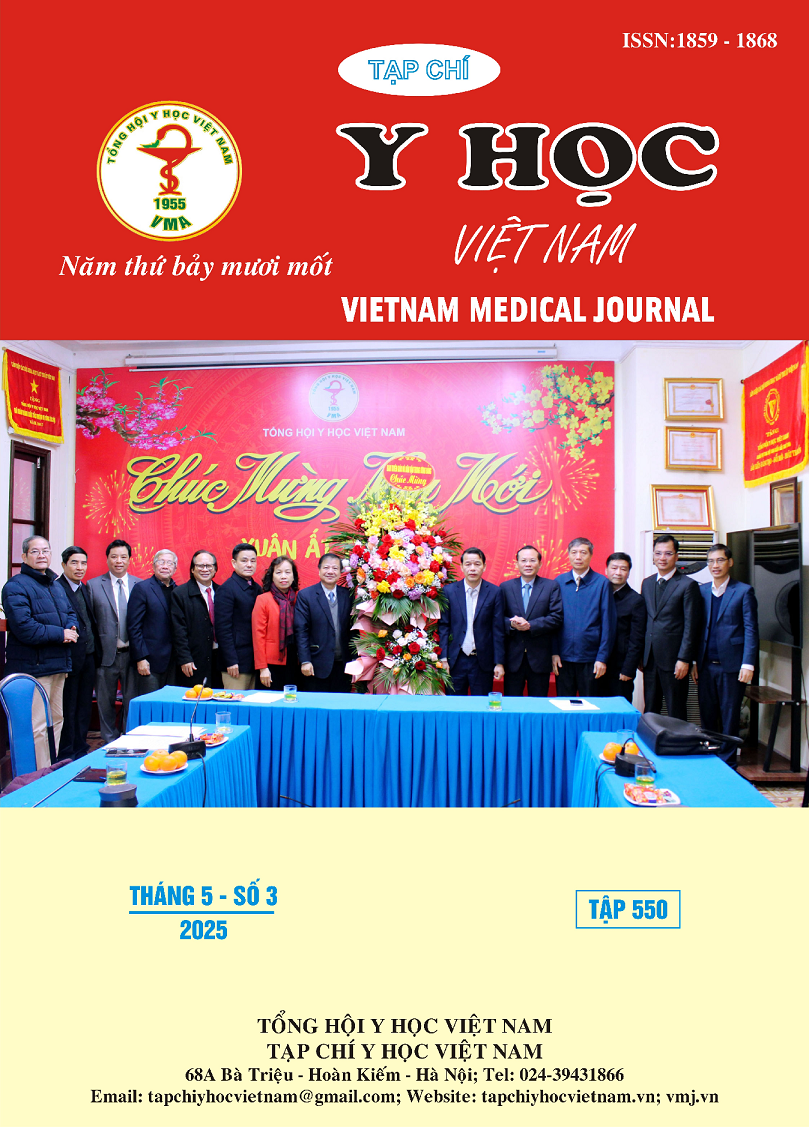ANTIMICROBIAL RESISTANCE PATTERNS IN RESPIRATORY PATHOGENS AT THU CUC INTERNATIONAL GENERAL HOSPITAL DURING 2022-2023
Main Article Content
Abstract
Objectives: Describe the characteristics of common bacterial pathogens in respiratory infections and to assess the antibiotic resistance patterns of these bacteria at Thu Cuc International General Hospital during the period 2022-2023. Subjects and method: A cross – sectional descriptive study on microbiological data of 238 bacterial strains isolated from 227 respiratory specimen of patients treated at Thu Cuc International General Hospital from January 2022 to December 2023. Result: Gram-negative bacteria were the main cause of respiratory infections (72.3%), with the highest incidence of Haemophilus influenzae (35.3%) and Moraxella catarrhalis (31.9%). The most common Gram-positive agent was Streptococcus pneumoniae (18.5%). Resistance to frequently used antibiotics among respiratory pathogens, such as beta-lactam/beta-lactamase inhibitors and cephalosporins tends to increase. H.influenzae had a high rate of resistance to β-lactam antibiotics (>90%) but was more than 80% sensitive to quinolone and carbapenem. M.catarrhalis remained highly sensitive to beta-lactam/beta-lactamase inhibitors, sulfamethoxazole, tetracyclines, cephalosporins, aminoglycosides, macrolides, and fluoroquinolones. S.pneumoniae showed 90.24% resistance to erythromycin and over 60% resistance to most beta-lactam/beta-lactamase inhibitor antibiotics, except for Cefoperazone/Sulbactam, which had 97.62% sensitivity and 2.38% intermediate levels. Conclusion: Gram-negative bacteria were the main cause of respiratory infections (72.3%), with the highest incidence of Haemophilus influenzae (35.3%) and Moraxella catarrhalis (31.9%). Resistance to frequently used antibiotics among respiratory pathogens, such as beta-lactam/beta-lactamase inhibitors and cephalosporins tends to increase. The rational and wise use of current antibiotics is strengthened.
Article Details
Keywords
Antibiotics, antimicrobial resistance, antimicrobial agents, bacterial infections, respiratory infections, Thu Cuc International General Hospital
References
2. Lại Thị Quỳnh, Phạm Thị Tâm và cộng sự (2022). Các vi khuẩn gây nhiễm khuẩn hô hấp tại Bệnh viện Hữu Nghị Việt Tiệp Hải Phòng năm 2018 – 2020. Tạp chí Y học Dự phòng 32(4 Phụ bản), tr. 40-47.
3. Bộ Y Tế (2023). Báo cáo giám sát kháng kháng sinh tại Việt nam 2020.
4. Hoàng Thị Bích Ngọc, Cập nhật dữ liệu đề kháng kháng sinh trong nhiểm khuẩn hô hấp cộng đồng tại Bệnh viện Nhi Trung ương năm 2020-2021. 2021.
5. Tăng Xuân Hải, Trần Minh Long và cộng sự (2022). Nghiên cứu tính kháng kháng sinh của một số loài vi khuẩn gây bệnh phân lập được tại bệnh viện Sản Nhi Nghệ An 2021. Tạp chí Y học Việt Nam, 512(1), tr.15-20.
6. Torumkuney D, Van PH, et al. (2020) Results from the Survey of Antibiotic Resistance (SOAR) 2016–18 in Vietnam, Cambodia, Singapore and the Philippines: data based on CLSI, EUCAST (dose-specific) and pharmacokinetic/ pharmacodynamic (PK/PD) breakpoints. Journal of Antimicrobial Chemotherapy, 75 (Supplement_1), pp. i19-i42.
7. Vũ Thị Thu, Nguyễn Thị Diệu Thúy và cộng sự (2023). Căn nguyên và tính đề kháng kháng sinh của vi khuẩn gây viêm phổi cộng đồng tại bệnh viện Sản Nhi Nghệ An. Tạp chí Y học Việt Nam, 529(1), tr.25-36.
8. Đặng Thị Thùy Dương (2018). Nghiên cứu đặc điểm lâm sàng, cận lâm sàng theo căn nguyên vi khuẩn gây viêm phổi ở trẻ dưới 5 tuổi tại Bệnh viện Nhi Thái Bình. Luận án Thạc sỹ, Đại học Y Hà Nội.


